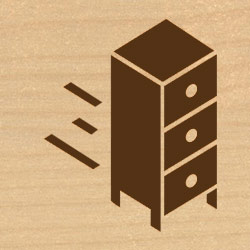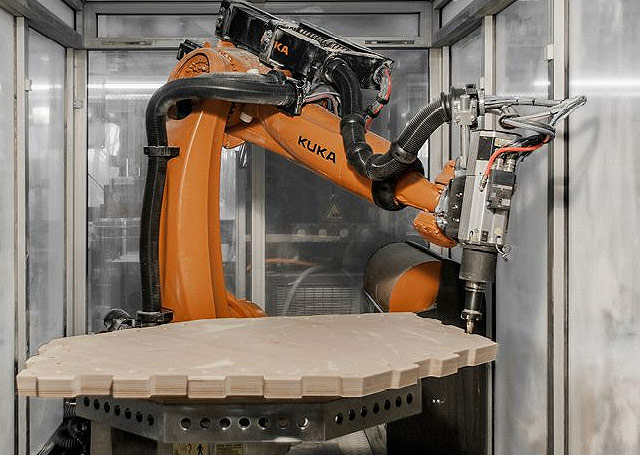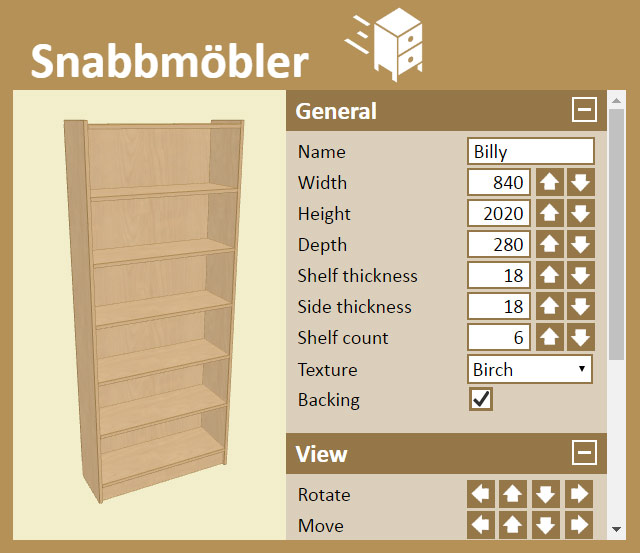Snabbmöbler
 This is an idea for a business that manufactures custom furniture using particle board. The client designs the furniture using a simple computer interface, and the furniture is then quickly manufactured using robots, and delivered as pieces in a box, IKEA style.
This is an idea for a business that manufactures custom furniture using particle board. The client designs the furniture using a simple computer interface, and the furniture is then quickly manufactured using robots, and delivered as pieces in a box, IKEA style.
Slogan: We guarantee to have the furniture you want, because you design it yourself.
Snabbmöbler is Swedish for "fast furniture".
The client experience
I got this idea when I lived in Medellin, Colombia. If you go their home improvement shops to buy some particle board, they also offer blueprints of simple furniture like bookshelves. For an additional fee, they will manually cut up all the pieces needed for a complete bookshelf, from the particle board of your selection.
To take this idea one step further, imagine having the following client experience:
- You go to a web site and select the type of furniture you want to buy, for example a bookshelf, table, drawer, closet or bench.
- You customize the furniture item to fit your need; the color and texture, the sizes in all dimensions and decorative details, by simply clicking on buttons. The page guides you through the process and displays relevant information, for example how much load your designed bookshelf can take, the total weight of the item, etc.
- You go to the order screen and pay for the item.
- You pick up the item one hour later at a local shop, or alternatively have it delivered to your home.
- You assemble the item yourself, IKEA style.
The advantage over traditional furniture shopping is that you can always get exactly the style, color and size that fits your room. And the furniture will never go out of manufacture. If you have a certain style of bookshelf already, you are guaranteed to be able to order a perfectly matching one.
The technical implementation
Each shop has three areas:
- The warehouse where the raw material is stored. This is stacks of particle board in a few different thicknesses and with various melamine coated colors/textures. There is also a stock of screws, hinges and other items needed to assemble the furniture.
- The manufacture area. Here automated industrial robots mill the boards to specification (cut to size, drill holes, glue endstrips, etc). And the resulting pieces are packed in cardboard boxes for delivery.
- The client area. This has a showroom with examples of furniture, several touchscreens where you can order furniture, and a cafe where you can relax and wait for your order to be completed.
The production of a furniture piece involves the following steps:
- Order. The client customises the furniture, and places the order, either in his home or on a touchscreen in the shop.
- Material allocation. The order computer breaks down the furniture into parts, and figures out how to cut the parts with minimum waste, combining with other furniture in the production queue.
- Material delivery. Workers in the warehouse look at their order screens to see how many boards of certain types are needed at the different robot stations, and use forklifts to deliver those boards.
- Robotic milling. The robot at each station receives CNC instructions for the next upcoming particle board. It places the board in its jig, and starts milling. The resulting pieces are labelled and placed on the parts belt.
- Packaging. At the end of the parts belt are workers who receive the parts, do quick quality control, and put the pieces in cardboard boxes together with assembly instructions and hardware items such as screws.
- Delivery. The furniture package travels on a belt and arrives in the client area to be picked up by the client. Alternatively it is stored for the next shipping pickup.
Below: Robotic milling of wood.

Advantages over traditional furniture stores
Traditional: Ready made furniture that take a lot of warehouse space.
Snabbmöbler: Stacks of particle board that take small warehouse space.
Traditional: Last year's model hard to sell, cost hard to recover.
Snabbmöbler: Always made to order, there is no stock of last year's model.
Traditional: Source items at medium volume, hard to get economy of scale.
Snabbmöbler: Source few items and in high volume, easy to negotiate prices.
Traditional: Out of manufacture items make clients disgruntled.
Snabbmöbler: All styles of furniture always available.
Traditional: Out of stock items make clients impatient.
Snabbmöbler: All items can be available within an hour.
Traditional: "One size fits all" thinking, which rarely makes a perfect fit.
Snabbmöbler: Encourages individuality, with the best possible fit.
Traditional: Spare parts rarely offered.
Snabbmöbler: Parts of a furniture can be ordered. Easy repairs, easy modifications.
Traditional: No price range offerings for a specific item.
Snabbmöbler: Each item comes in a price range, depending on materials selected.
Experiments with the order interface
I decided to brush up on my 3D programming skills and create a simple web based interface for furniture customization. It was implemented in Javascript and WebGL.
You click the arrows on the right, or type in new values to change the dimensions. You can also change the texture, and decide whether you want backing on the bookshelf. You use the mouse cursor to spin the item around so you can see it from every angle. A print button renders a high quality printout with basic data about the bookshelf.
Click here to try it yourself.

Competition
There exist a few websites that offer custom furniture, but none of them has the level of automation, speed or user interface sophistication of Snabbmöbler. They have a long way to go before clients would want to order furniture this way: hem.com, www.jali.co.uk, evolvex.com.au, nomi.com.au.
Viability
I really like the idea from a technical perspective. It would be very interesting to create the user interface, and the manufacturing process.
However the big elephant in the room is IKEA. They own every part of the process of manufacturing the particle board they use in the their furniture. It is unreasonable to think that Snabbmöbler could offer furniture at the IKEA price level. I checked the wholesale price of particle board, cost of robotics, staff, warehouse rent, etc, and concluded that prices would be 20% to 50% higher than IKEA for a similar product.
So are clients willing to pay a premium for the ability to get custom furniture? If the brand is built the correct way I think they would.
IKEA is perceived to be large, global/distant, impersonal, conformist, low tech, low excitement, but with low prices and Swedish pride. Snabbmöbler would be small, local/near, personal, individual, high tech, high excitement with medium prices. Snabbmöbler is branded as the future of furniture, while IKEA is the old stagnant model. For all we know, an IKEA furniture piece could have been made anywhere in the world, and several years ago. The Snabbmöbler furniture you just ordered is being manufactured right now, right here, and you can see through a window in the shop how the robot is busy milling your piece. This gives a sense of locality, connection and pride in supporting a local business.
In conclusion I would say that it is hard to go up against a giant, but if the branding is done right, this could be a viable business model.
